Covid hospitalisations in England have fallen for first time since third wave took off, official figures revealed today in another boost to hopes that the worst of the summer resurgence may be over.
Department of Health statistics show the average number of patients needing care stood at 785 on July 25, down on the day before (793).
It is the first time the figure — which is based on the seven-day average and offers a more reliable measure as to state of pressure on the NHS — has fallen since May 12.
Meanwhile, Britain’s daily Covid cases fell again today for the ninth day in a row, amid mounting confusion over true state of the third wave. Department of Health bosses posted 29,622 cases — down 18.6 per cent on last week.
In another glimmer of hope, deaths (68) appear to be slowing down — up just 6 per cent on last Friday.
But the actual state of crisis has baffled scientists, who say a multitude of factors could be behind the drop in official figures — including fewer people coming forward to get tested because of the ‘pingdemic’ chaos and fears of having to self-isolate.
Adding to the confusion today, random testing data claimed the outbreak in England continued to grow last week.
The Office for National Statistics (ONS), which carries out tens of thousands of random swab tests every week, estimated one in 65 people were carrying the virus on any given day in the seven-day spell ending July 24 — the equivalent of 856,200 positive cases.
But experts say the overall trend is still pointing downwards, and that the ONS data lags behind and may not show the drop for another week or two because it does not represent current infection rates.
Meanwhile, SAGE — which warned that official figures could drop because of fewer tests being carried out after the school summer holidays — claimed the R rate across the country had fallen slightly and may now be as low as 1.1.
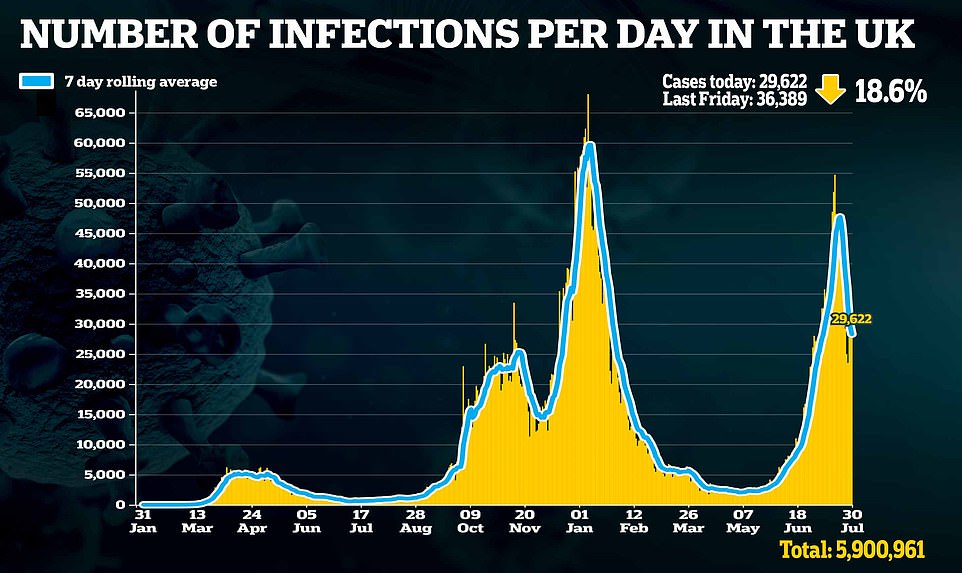
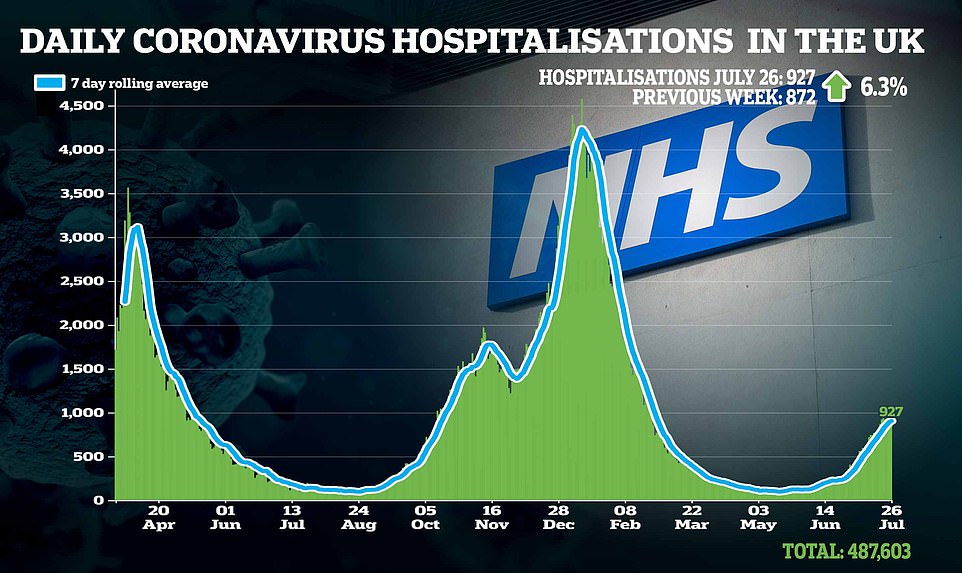
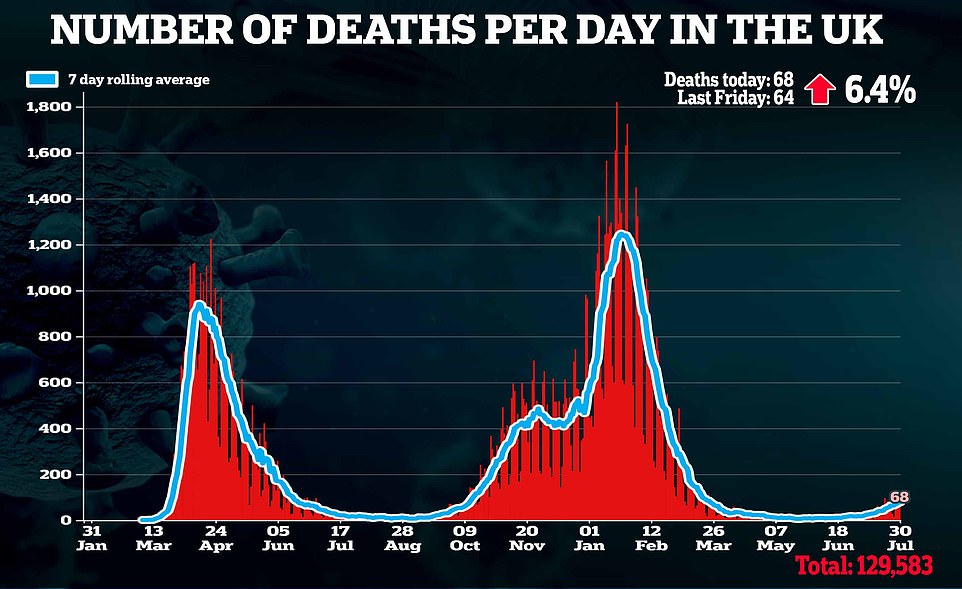
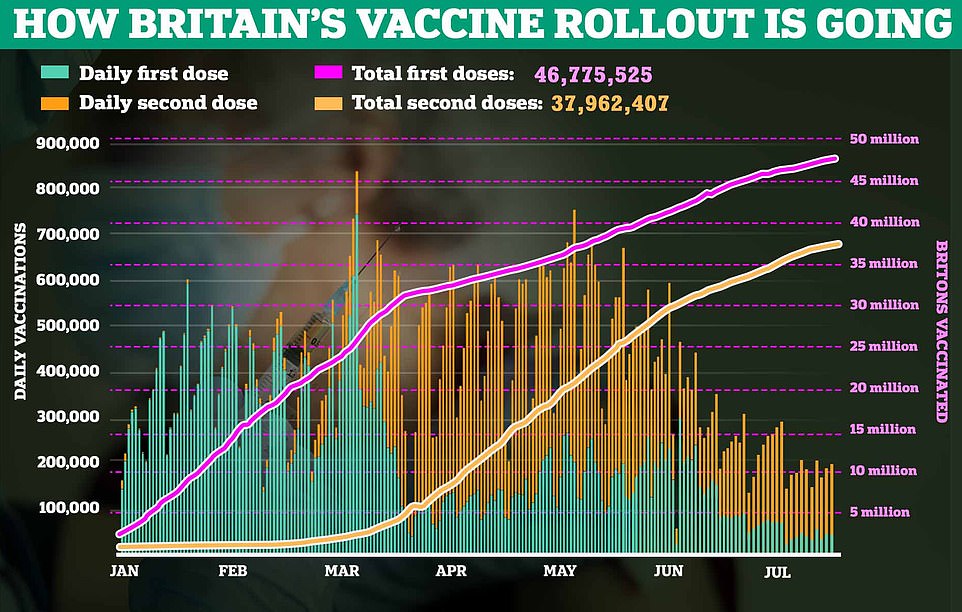
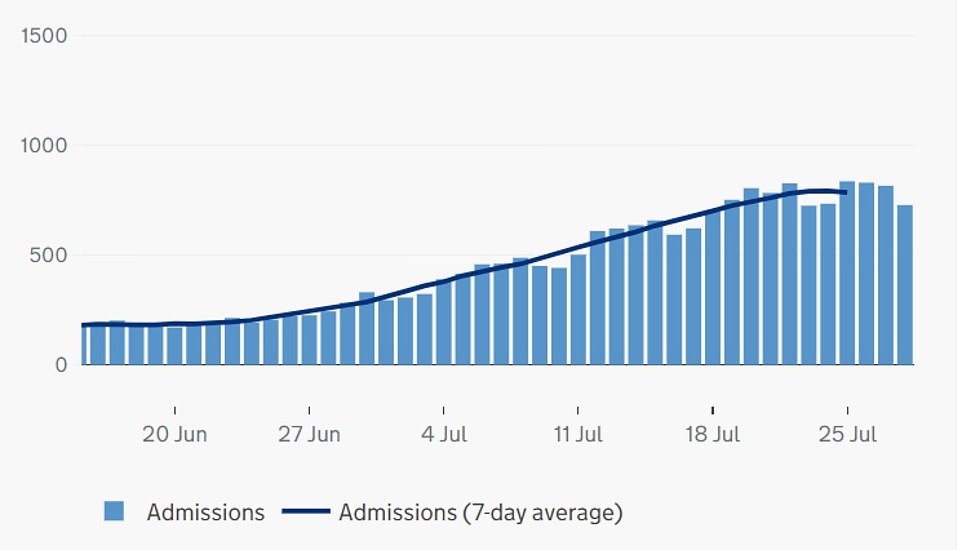
ENGLAND COVID HOSPITALISATIONS: Department of Health statistics show the average number of patients needing care stood at 785 on July 25, down on the day before (793)
Why the Delta Covid variant ISN’T really spreading as quickly as chickenpox
Top scientists today claimed the Indian ‘Delta’ variant is not spreading as quickly as chickenpox, despite US health officials saying it is just as contagious.
Data circulating within America’s Centers for Disease Control and Prevention (CDC) claimed people infected with the mutant strain can go on to infect eight others.
The same internal document also alleged that fully-vaccinated people can spread the Indian variant just as easily as unvaccinated people because they carry a similar amount of the virus in their nose and mouth.
Dr Rochelle Walensky, the director of the CDC, insisted the agency was ‘not crying wolf’, saying the situation was ‘serious’ and that the measures needed to tackle the spread of Delta were ‘extreme’.
But British scientists have questioned some of the claims made by the department, which has urged Americans to keep their coverings on indoors regardless of whether they’ve been vaccinated or not.
Professor David Livermore, an infectious diseases expert from the University of East Anglia, said vaccine-triggered immunity and the endless waves of Covid which nations have endured meant there were fewer susceptible people around for people to infect.
‘The US, like the UK, has substantial immunity from prior infection and from vaccination,’ he told MailOnline. ‘This will surely be a major drag on Delta’s spread, precluding (viral spread) numbers of that magnitude.’
And Professor Julian Tang, a virologist at Leicester University, said the theory was likely just ‘speculation’ because it was very difficult to track down the number of cases sparked by a single infection.
Advertisement
It comes as:
Sunseeker face chaos today as Greece threatens a crackdown over spiking cases on islands, ministers ‘tie themselves in knots’ over France quarantine, Spain looks on the verge of tougher curbs – and Italy is refusing to exempt Brits from self-isolation;British scientists claimed the Indian ‘Delta’ variant is not spreading as quickly as chickenpox, despite US health officials saying it is just as contagious;A study claimed men and women suffer different symptoms from Covid;Government scientists said plastic screens used in pubs and workplaces are unlikely to help in stopping Covid transmission;Data from the ZOE symptom study suggested Covid were not falling last week, in contrast with official figures, but plateaued.
The Department of Health data shows that hospital admissions in England have been falling for the last four days in a row.
Admissions fell 11 per cent week-on-week, down from 783 on July 21 to 728 on July 28.
New cases are still declining across the UK, but the number of tests taken has dropped 14.3 per cent in the last seven day, which could impact numbers.
Both the deaths and hospitalisation figures reported today are 6.3 per cent higher than they were seven days earlier.
Meanwhile, 42,410 more first vaccine doses were dished out, while 180,155 people became fully immunised against Covid.
This means 88.4 per cent of adults in the UK have had one dose, while 71.8 per cent are double jabbed.
Professor Paul Hunter, an expert in public health at the University of East Anglia, said: ‘The decline in case numbers as reported by the DHSC today do not conflict with the report from ONS from earlier in the day as one would not expect to see any impact of the recent decline in the ONS figures till next Friday.’
While cases are continuing to rise across England in ONS’s data, the 15 per cent increase spotted by its random-test survey marks a slow down on the previous projection (28 per cent).
The Government agency’s estimate today was based on swabs of more than 100,000 people in private homes across the country.
It does not include tests in hospitals or care homes, so only provides a rough assessment of how widespread the disease is among the community.
The ONS estimates the North East is still the hardest hit, with 3.2 per cent of people there testing positive for the virus.
It is followed by the North West (2.1 per cent), the West Midlands (1.9 per cent), London (1.7 per cent) and the East Midlands (1.7 per cent).
Covid positivity rates were lowest in the East and the South West (both 1 per cent).
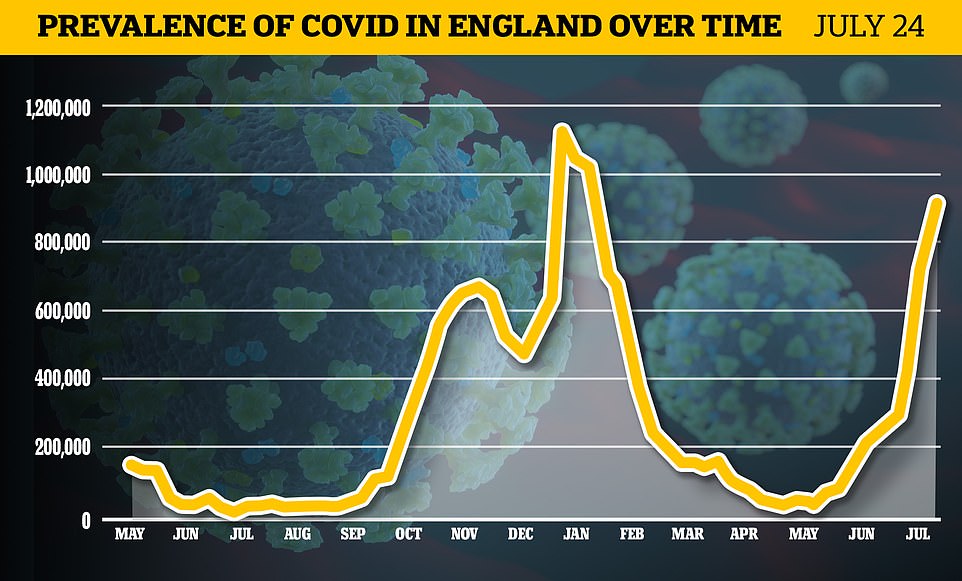
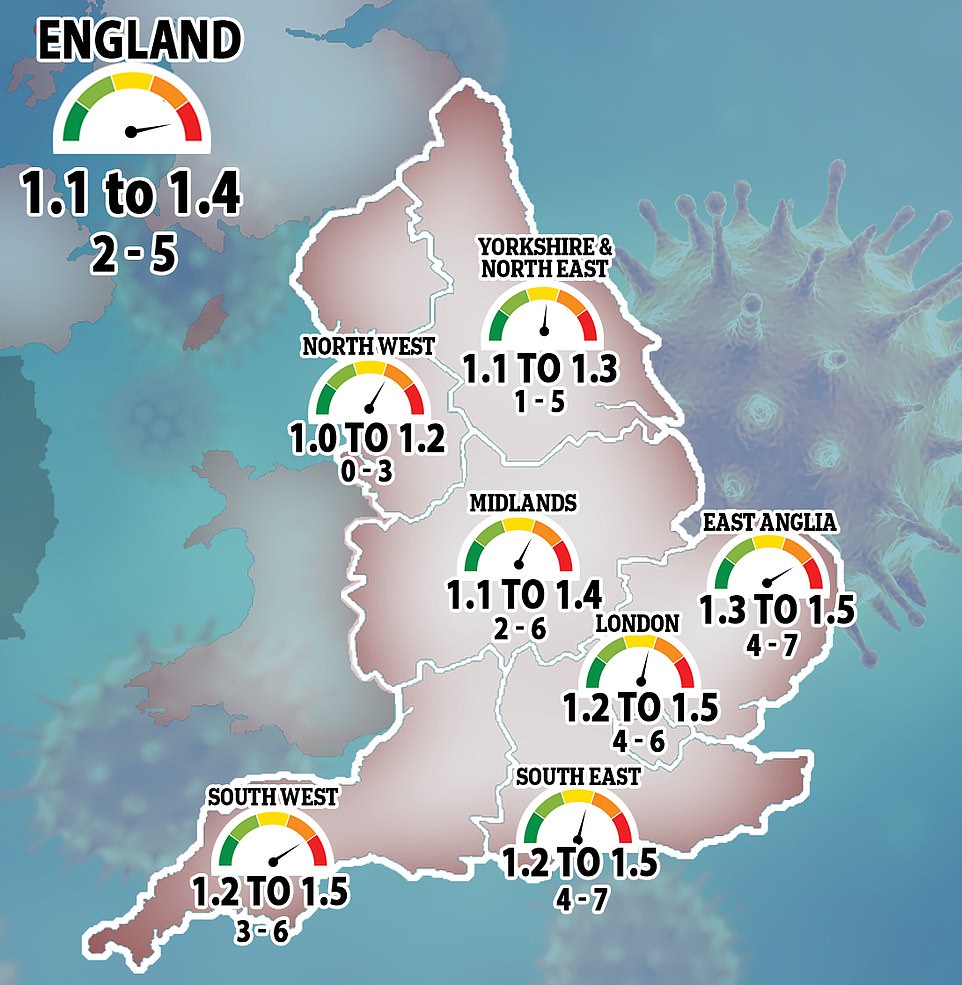
The Government’s Scientific Advisory Group for Emergencies (SAGE) said that England’s R rate was now thought to be between 1.1 and 1.4, but it was a varied picture across the country. The R rate was estimated to be the highest in the East (1.1 to 1.5), followed by London, the South East and the South West (all 1.2 to 1.5). Following these regions was the Midlands (1.1 to 1.4), the North East and Yorkshire (1.1 to 1.3) and the North West (1 to 1.2)
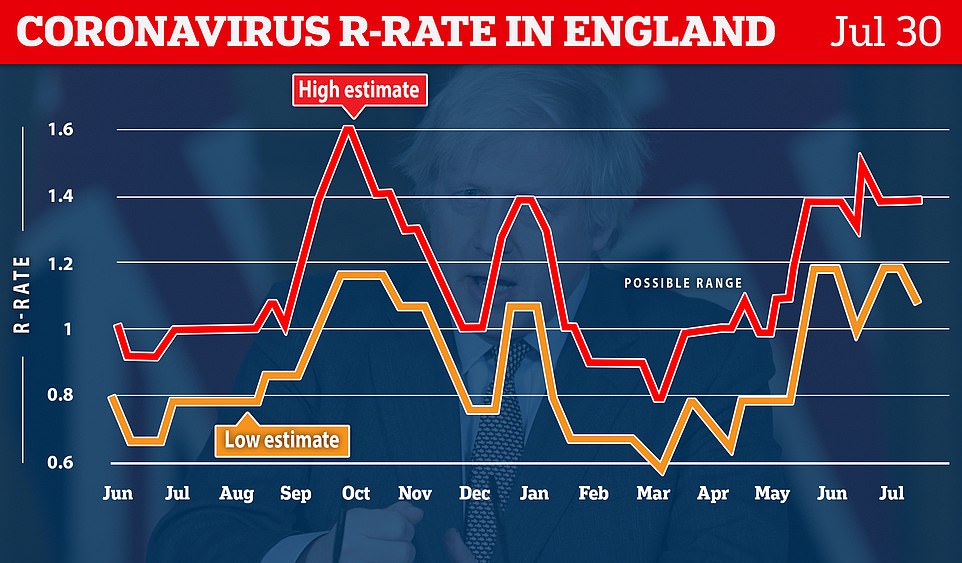
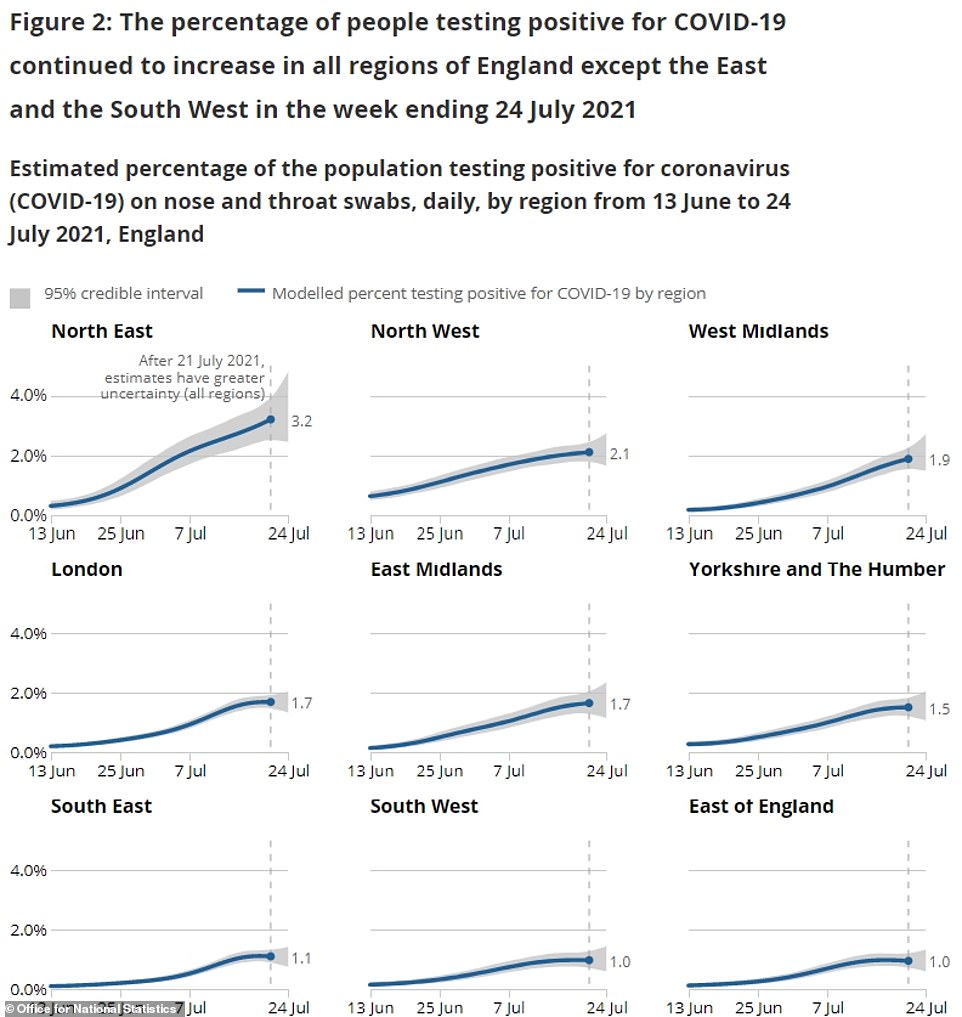
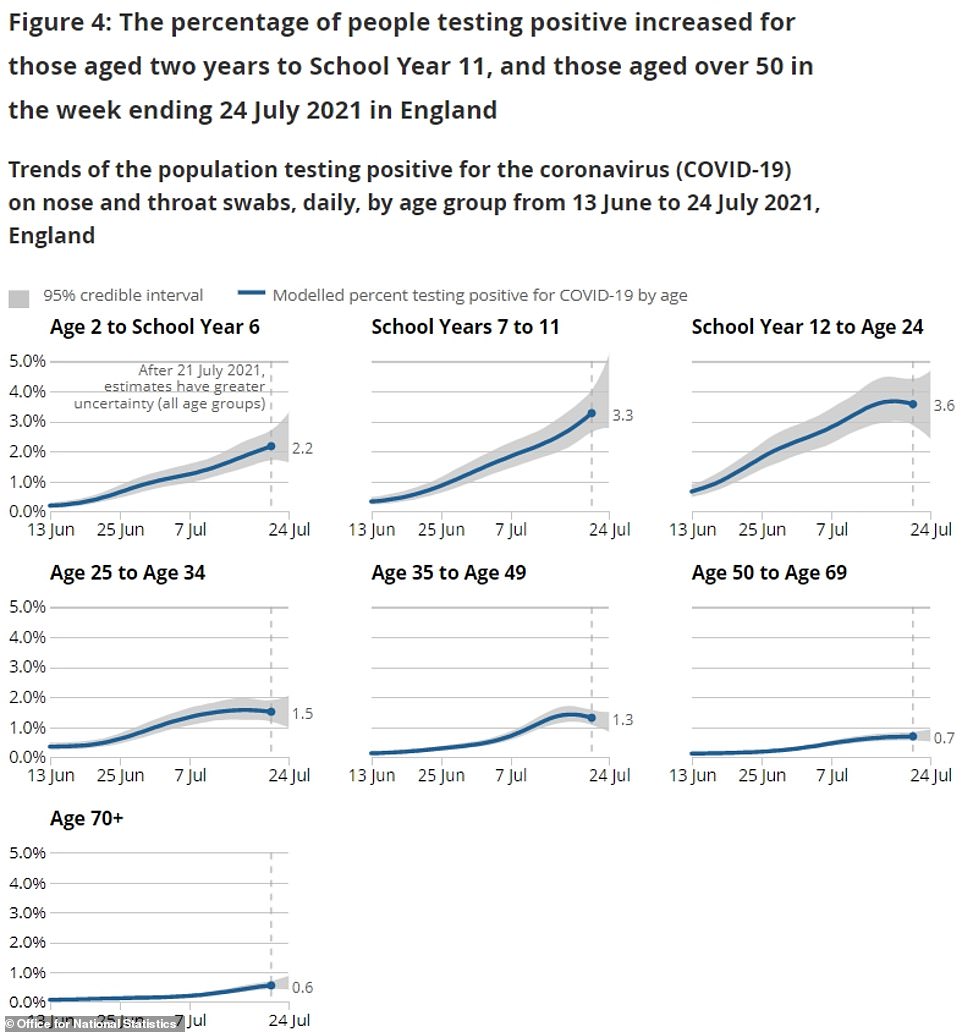

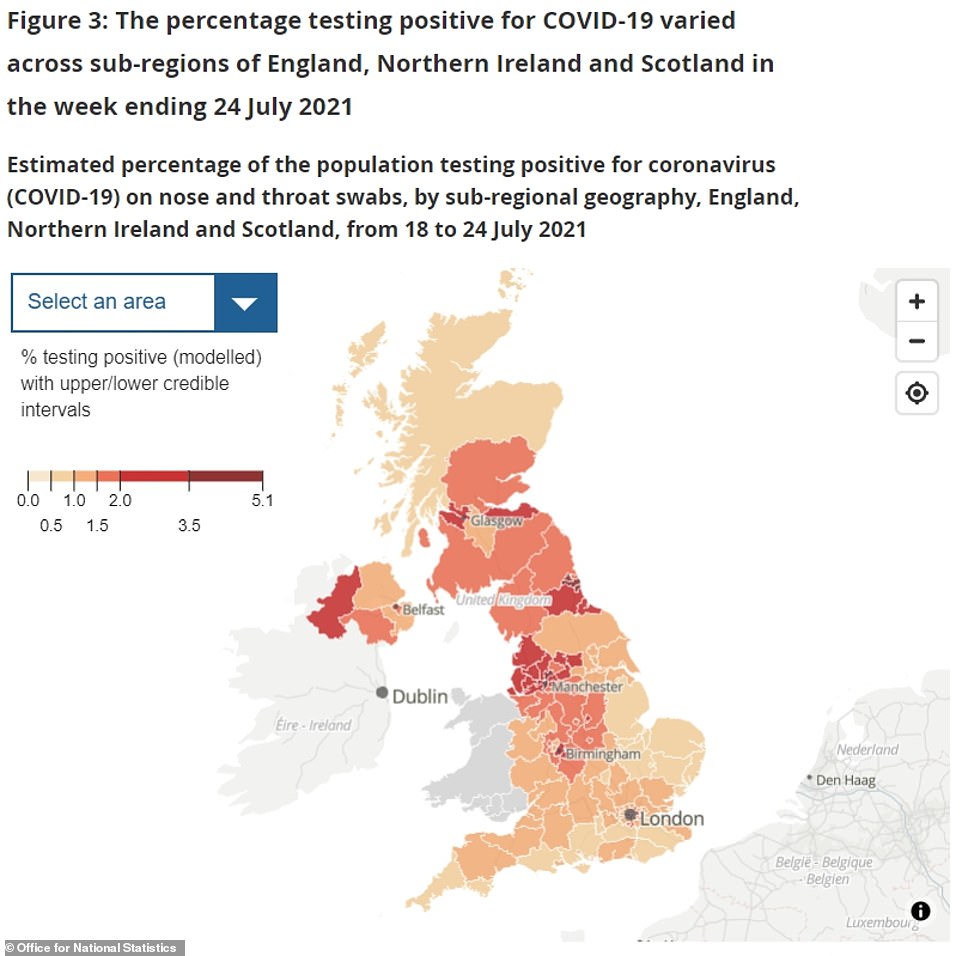
How Covid symptoms differ between genders
Men and women suffer different symptoms from Covid, a study has claimed.
Researchers at King’s College London looked at data from 38,000 infected adults.
They discovered men were more likely to suffer shortness of breath, fatigue, chills and a fever.
Meanwhile, a loss of smell, chest pain and a persistent cough appeared to be most common among women.
Traditionally, Covid’s main three symptoms are considered to be fever, a persistent cough and loss of smell.
But academics found fever was not an early feature of the disease in any age group — despite being a known symptom.
The research — which took data from Zoe’s Covid Symptom Study app — also found those aged 60 and above were more likely to report diarrhoea.
And a loss of smell — one of the hallmark signs of the illness — was less common among older adults.
The findings, published in the journal Lancet Digital Health, are based on modelling using artificial intelligence to predict early signs of Covid infection.
Data from the app has previously shown vaccines had helped turn Covid into a ‘bad cold’.
Double-jabbed Britons who catch the virus are now more likely to suffer a headache, runny nose, sneezing and a sore throat than the ‘classic’ three symptoms.
Officials have repeatedly refused to expand the Covid symptoms list to include more warning signs, despite evidence showing the disease has changed.
Advertisement
Different trends were spotted across the country, with cases appearing to fall in the East and South West, but the ONS said this trend was uncertain.
Cases were also growing in Wales and Northern Ireland last week, while the rate of people testing positive dropped in Scotland.
Data shows 1.57 per cent of people tested in England had Covid, compared to Northern Ireland (1.48 per cent), Scotland (0.94 per cent) and Wales (0.62 per cent).
Mirroring infection rates in England, the ONS estimated 27,200 people were infected in Northern Ireland last week, equating to one in 65 people.
Rates were much lower in Scotland, where one in 100 people were thought to have the virus (49,500 cases), and Wales, where just one in 160 people were infected (18,800 cases).
Professor Hunter said: ‘The important point to point out is that the ONS survey largely covers a period prior to the decline in cases, especially as this is a prevalence survey and people can be positive for some time after acquiring their infection.
‘We will have to wait till next week before we can see any indication of the recent decline in cases.
‘Generally changes in ONS data lag about two weeks behind daily cases data.’
It came as the Government’s Scientific Advisory Group for Emergencies (SAGE) said that England’s R rate was now thought to be between 1.1 and 1.4.
For comparison, No10’s top advisory panel thought the actual figure was somewhere between 1.2 and 1.4 in last week’s update.
It means that on average, every 10 infected people are currently passing the virus to between 11 and 14 others.
But the estimate lags several weeks behind the current situation because of the way the R is calculated, which relies on deaths and hospital admission figures as well as mobility data.
The R rate was estimated to be the highest in the East (1.1 to 1.5), followed by London, the South East and the South West (all 1.2 to 1.5).
Following these regions was the Midlands (1.1 to 1.4), the North East and Yorkshire (1.1 to 1.3) and the North West (1 to 1.2).
The SAGE experts also estimated Covid infections were growing between two and five per cent every day.
But separate data released yesterday by Public Health England revealed infection rates are going down in all of the country’s local authority among all ages apart from the over-80s.
The agency’s weekly report showed, however, that fewer tests were being carried out which may be behind the drop in cases.
But the positivity rate — the proportion of swabs that detected the virus — also fell, suggesting the trend is genuine and not skewed by a lack of swabbing
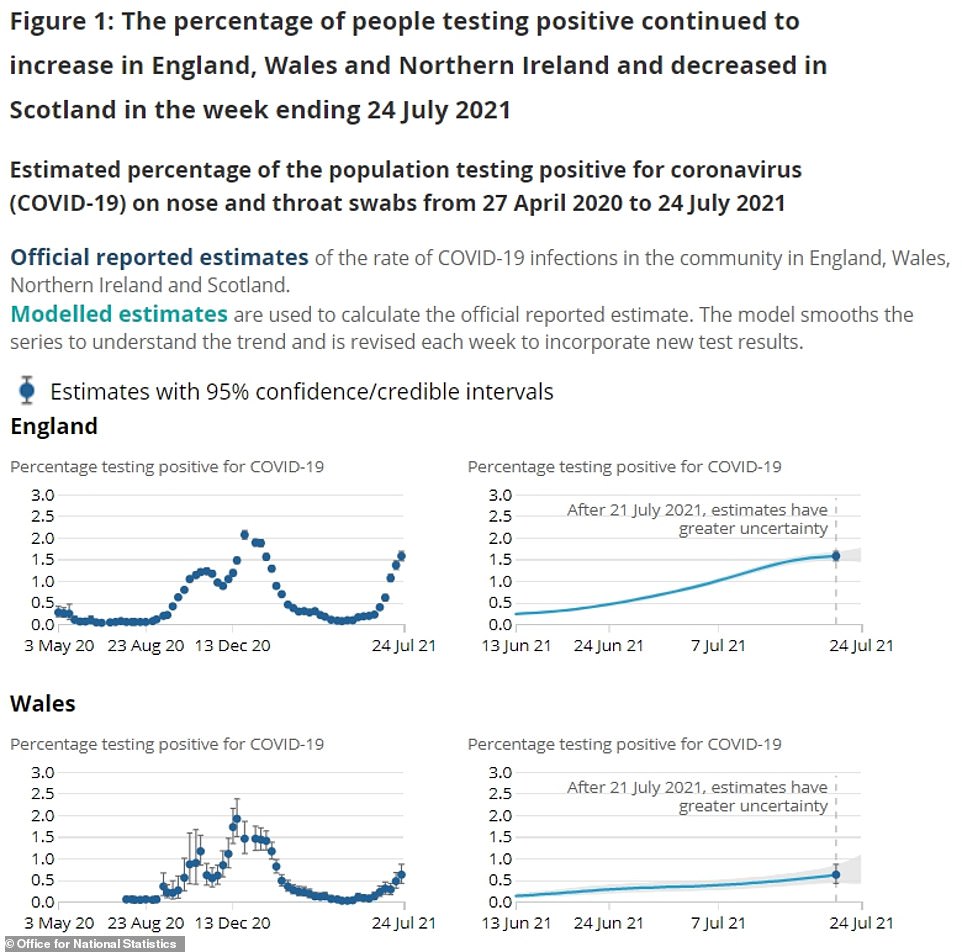
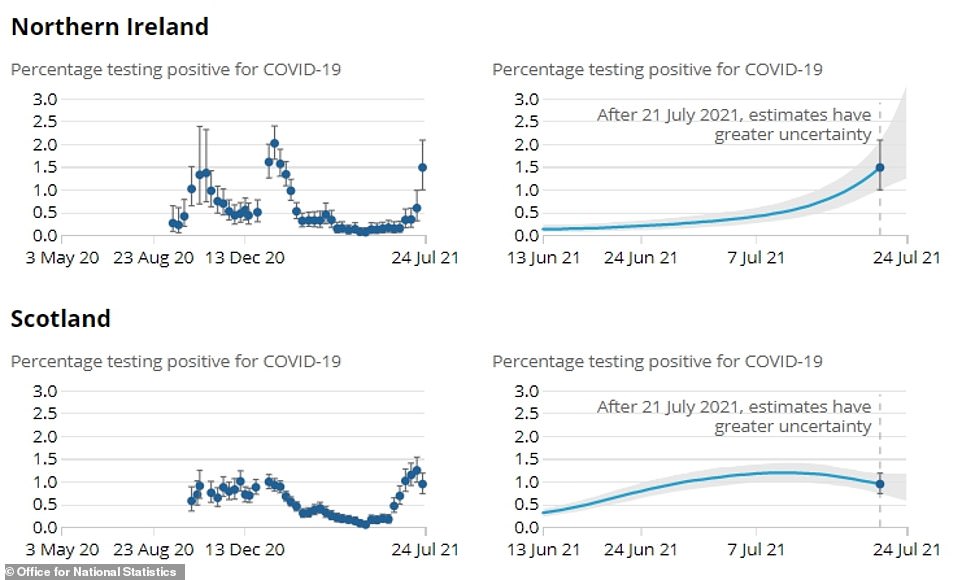
European travel war erupts: Chaos as ministers squabble over why France was hit with ‘amber plus’ quarantine rules
Fears were raised of a European ‘travel war’ today amid a bitter row over the UK’s restrictions on France, the threat of Spain being hit by quarantine rules – and Italy refusing to exempt Brits from self-isolation.
Hopes of escaping the dismal summer weather have been dealt more blows with ministers effectively warning the public they must get used to confusion and uncertainty, with a patchwork of ever-shifting rules in place at home and internationally.
In an extraordinary public volte face, Transport Secretary Grant Shapps was sent out to contract a claim from Dominic Raab that France was hit with ‘amber plus’ quarantine rules because of Covid cases on Reunion island 6,000 miles away.
The suggestion sparked a furious reaction from Paris, with an ally of Emmanuel Macron raging that the UK position is discriminatory and ‘baffling’.
Meanwhile, Spain is believed to be at risk of being moved up the ‘traffic light’ system in a review next week, even as double-jabbed travellers from the rest of the EU and the US are due to be exempted from quarantine.
As tensions rise, Italy is reportedly not reciprocating the get-out granted by Britain to its citizens, meaning vaccinated holidaymakers will still need to isolate on arrival.
There are claims that EU leaders are resisting easing rules for Britons partly out of ‘frustration’ with the standoff over Brexit.
The chaos is such that Britons appear to be giving up on going away. An exclusive poll for MailOnline has found that just 14 per cent are intending to travel abroad for a summer holiday this year.
The decision on France two weeks ago led to thousands of fully-vaccinated holidaymakers having to self-isolate for ten days on their return.
The diplomatic spat escalated over recent days after the country was excluded from a UK quarantine exemption for travellers who have been double-jabbed in the EU.
French Europe minister Clement Beaune yesterday branded the UK’s stance towards his country ‘excessive and frankly baffling’.
‘If I understood correctly, this is being done in the name of the famous Beta variant, the South African variant, which represents less than 5 per cent of cases in France, most of which are in our overseas territories that are not affected by the same flows of people towards the UK,’ he said.
In a round of interviews this morning, Mr Shapps said the decision had been down to ‘overall concern’ about France, not the situation on Reunion.
‘The Beta variant, it’s not just – as has been reported – on an island thousands of miles away. It was also an issue in particular in northern France, so it has been an overall concern,’ he told Sky News.
‘And look, the big concern is that we don’t allow a variant in which somehow is able to escape the vaccine programme that we have got.’
Mr Shapps said a decision on France’s status will be taken ‘by this time next week’ as part of the regular travel list update every three weeks.
Asked if there could be a change before then, the minister told BBC Radio 4’s Today programme: ‘No, it’s only six days away actually, so I wouldn’t expect anything in advance of that, but it is the moment at which this will be looked at.’
Pushed on whether that meant no move on Spain before then, Mr Shapps said: ‘That’s right. I would encourage people to broadly ignore the sort of ongoing speculation as much as is possible.’
He added: ‘One thing I have seen over the last year with all this going on is that, quite often, the speculation is not all that helpful, or all that accurate indeed.
‘When we get the information from the Joint Biosecurity Centre, that’s the first point at which it really becomes clarified.’
A senior government source also slapped down Mr Raab, insisting that he had been wrong.
The source said: ‘Ministers took this decision based on data on the prevalence of the Beta variant in mainland France.’ They added: ‘This data did not include La Reunion.’
Mr Raab’s comments led to fresh criticism of the Government’s decision, which many are hoping will be reversed next week.

A Redfield & Wilton Strategies poll for MailOnline found just 14 per cent of Brits are planning a summer holiday abroad this year
Advertisement
In the latest week to July 25 PHE found Covid cases dipped in all areas, with the biggest decline in England’s hotspot the North East, where infections almost halved in a week (46 per cent) to 520 cases per 100,000 people.
It was followed by the West Midlands where infections fell by two fifths (40 per cent) to 415 per 100,000, and the North West where they dropped by almost two-fifths (37 per cent) to 380 per 100,000.
And when the data was divided by age groups adults in their twenties saw the biggest fall in infections after they almost halved in seven days (down 48 per cent) to 616 cases per 100,000 people.
The second-biggest drop was among adults in their thirties where they fell by almost two-fifths (37 per cent) to 476 per 100,000, and those aged 10 to 19 where they also fell by almost two-fifths (36 per cent) to 658 per 100,000.
But another report from the ZOE Covid symptom-study app yesterday suggested cases are not falling as fast as official figures suggest, and may have only plateaued last week.
In the latest week it estimated 60,480 people were catching Covid in the UK every day. This was barely a change from the previous seven-day spell.
Experts said the ‘chaotic’ datasets were likely reflecting ‘a lot of different things going on at the same time’, including the start of the summer holidays, hot weather and easing restrictions on Freedom Day July 19.
The ONS data today also revealed coronavirus is the most prevalent among 17 to 24-year-olds, with 3.6 per cent of the age group testing positive.
But it estimated that cases are starting to drop in that age group.
However, infection rates were continuing to rise in younger groups, with 2.2 per cent of children in year six and below testing positive and 3.3 per cent of 11 to 16-year-olds having the virus.
Infection rates were lowest in the over-70s (0.6 per cent).
Professor Kevin McConway, a statistician at the Open University, said many experts ‘were somewhat surprised’ by the fall in daily infections reported by the Government every day over the last week, and ‘it’s still not clear what the reasons for it might be’.
He said: ‘One possibility, though, is that, to some extent at least, it might not represent a true fall in the number of new cases.
‘The new case counts on the dashboard come from numbers of people testing positive for the virus, so they depend on how many people turn up to be tested, and on why people are being tested.
‘If those things change, that might cause changes in the numbers of confirmed cases that do not properly reflect what is actually going on in the country, in terms of infections.
‘And it’s possible that they may have changed recently, because of tests of school students changing as school close for the summer, and perhaps because the concerns about people being ‘pinged’ by the NHS Covid-19 app and having to self-isolate could be deterring some people from coming forward to be tested.’
Professor Francois Balloux, an infectious diseases specialist and epidemiologist at University College London, tweeted that about one third of people who have had Covid still test positive three weeks after infection.
‘The ONS is very useful data but not for recent case numbers. It’s a lagged indicator of the dynamic of the epidemic,’ he said.
Professor James Naismith, the director of the Rosalind Franklin Institute, said the ONS data contains ‘some hopeful news, some bad news and some troubling news’.
The rate of increase in England is slowing and the small decline in Scotland is hopeful, he said. ‘Where Scotland goes it is likely England will follow in time,’ Professor Naismith added.
But he said: ‘The bad news is that the UK (all its parts) have a very high rate of prevalence. The prevalence of the virus continued to increase up to July 24 in England, that is more people were infected than got better; the very definition of increasing spread.
‘The troubling news is that the daily number of test positives are currently a worthless guide to what is happening. The test positive daily data showed the beginning of a sharp drop in positive cases, we can now say this is not an accurate description of where things are.
‘There is an estimate of the daily incidence per day; it’s in the spreadsheet. It is presented as 11.57 per ten thousand for the week ending July 10.
‘With a population of 56million in England, this is over 60 000 infections per day. The test positive data for that week are around 30, 000 for England. We are back to our old problem, around half the infected people are not being identified.
‘I am not qualified to offer an explanation as to why the daily test numbers lost track of the infection at the moment (they will recover I am sure).’
To get infection rates under control, Professor Naismith said the vaccine rollout should be expanded to over-16s and ventilation in schools and other in-door venues should be improved.
He added: ‘No matter what, we are not going to rerun the deaths or illness we say in January, the vaccines have made a huge difference.’
But the continued risks are long-Covid in young age groups, the Indian ‘Delta’ variant seeking out those with weak immunity and the wearing down of NHS staff, who have not had a break, he said.
Source link : https://www.dailymail.co.uk/news/article-9843691/Covid-infection-rates-England-going-random-testing-reveals.html











